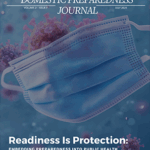Is the terrorist threat against the United States (domestically and internationally) increasing, and who is prepared? These are fundamental questions that need to be asked and answered. Before 9/11, after-action reports indicated the warning light had been blinking red, but “not everyone was convinced.” That light may be blinking red again. With a significant presence in the Middle East, the United States has been drawn into military action and increasingly targeted by groups such as Iranian networks, Hamas, Hezbollah, and the Houthis. Destroying or curtailing the military capabilities of these entities would limit their options for direct confrontation, but could expand asymmetrical operations and threats. For many in the United States, this raises a major concern and one that bears increased scrutiny and preparation to ensure that any attempts are thwarted.
Terrorist Threats Are Real
The 2018 movie Sicario: Day of the Soldado portrays human smugglers aiding suicide bombers’ infiltration through the American southern border in order to attack U.S. cities. This fictional account reflects more recent Department of Homeland Security National Terrorism Advisory System Bulletins that identify the potential of bad actors entering the country illegally to perpetrate violence (e.g., Iranian-backed plots disrupted by U.S. law enforcement).
Terrorist attacks can have far-reaching psychological, social, and economic impacts on communities beyond the initial target. In most cases, large cities are the primary target, due to their prominence and population density. Smaller communities, because of their size, may have fewer soft targets, “rural…towns should not count themselves exempt from the reaches of terrorists. Instead, these areas carry risks of their own—though vastly different from their urban neighbors, they are nonetheless present with dangers and potential outcomes.” However, a terrorist attack like the one in Boulder, Colorado, in June 2025 could still be particularly devastating to a smaller community, destroying community groups, straining limited resources, and reducing resilience.
Inherently, small communities in the United States are identified by close community connections and often vulnerable infrastructure that are not easily replaced, including rail systems, hospitals, schools, and commercial buildings. These features create an environment that provides increased shock potential. Beyond the impact on local infrastructure, the close community fabric could amplify the psychological impact. Survivors are more likely to be familiar with victims who may have deep roots in the community.
The Impacts on Smaller Communities
Extrapolating lessons and experiences from attacks on larger cities can help determine potential impacts on smaller communities. For example, some of the health, emotional, psychological, social, economic, and infrastructural effects from the attacks during and after September 11, 2001, still linger in 2025.
Emotional and Psychological Impact
The aftermath of terrorist attacks can carry an overwhelming mixture of fear, grief, and psychological trauma. The more familiar a community is with the place, the victims, and the survivors, the greater the psychological repercussions could be. The attack would be felt more as an assault on the community than on individuals. Reminders of the attack would remain long after the incident and recovery phases. For example, after 9/11, first responder agencies in smaller counties and communities were overwhelmed for months by white powder reports to the point that it became operationally exhausting for them. On New Year’s Day 2025, a deadly vehicle attack in New Orleans, Louisiana, increased fear of potential attacks against gatherings in other locations.
Social Impact
A terrorist incident can shatter community bonds of certain groups, leading to a mistrust of others in the community who may be from another country or religion. Such incidents may lead to targeted threats against entire groups of individuals. For example, after the 9/11 attacks, some groups were targeted because of their religious or ethnic identification. Even more recently, because of ongoing conflicts in the Middle East, some groups have been attacked because of their religion. For example, in a recent article in Time Magazine, “Cases of antisemitism and hate crimes towards Jewish Americans have surged in recent years, particularly since the start of the Israel-Hamas war in October 2023.”
Economic Impact
A small community’s economy is often dependent on small businesses and local industries. These businesses could include “mom and pop” stores, local restaurants, tourist attractions, or local industry. An attack on a small community could frighten potential tourists who then avoid the area, costing local businesses. After a disaster, many businesses (40%) never reopen, and many more fail within one year.
Infrastructure Impact
Support systems such as hospitals, emergency medical facilities and transport, and emergency management response systems are limited in small communities. In some cases, these support systems may be remote. If a terrorist were to attack, emergency systems could be quickly overwhelmed. There could be a greater impact on small communities where agencies are not trained or prepared for a terrorist attack or its cascading effects.
Threats, Threats, and More Threats
The threat level for terrorist attacks in small communities varies based on infrastructure targets and societal factors within the local area. However, limited targets do not in any way diminish the possibility of an attack. Impacts of a terrorist attack depend on the scenario:
- Railway Systems. An attack perpetrated on a railway system with little probability of discovery until it is too late would have the largest impact.
In 1978, in the small community of Youngstown, Florida, a lone individual systematically removed bolts and spikes that secured rails together, and he pulled the rail to the side. The damage was not visible from the locomotive, and the train carrying loads of chlorine derailed. The resulting crash released a gaseous chlorine cloud that killed 8 and injured 158 others. Because a major highway ran next to the tracks, most of those killed lost their lives as they drove into gas and their vehicles stalled. Efforts to remove the rail involved a crowbar, assorted wrenches, and about thirty minutes of effort. While rail safety and security have evolved, the threat of this type of event remains.
- School Attack. Active assailant scenarios may involve more than just firearms, which have become familiar to many first responders.
In 1927, the first U.S. school bombing took place at the Bath Consolidated School in Bath Township, Michigan, by a suicide bomber who planted bombs inside the school, killing 38 children, 6 adults, and the bomber, and injuring 58.
In another incident on Sept 1, 2004, terrorists stormed a school in Beslan, Russia. Beslan has a population of approximately 36,000, which compares to that of a small U.S. community. Over 330 people were killed.
- Vehicle-Borne Improvised Explosive Device (VBIED).
In May 2025, a facility in Palm Springs, California, suffered an attack by a VBIED. The VBIED was made from a combination of ammonium nitrate and fuel. This was the same explosive that was used in the Oklahoma City bombing in 1995.
In January 2025, in Las Vegas, Nevada, an attempted VBIED attack on a hotel resulted in minor damage. The attempt failed, but the attack was real.
These are but a few examples of terrorist attacks from the past. Whether criminally or terror-motivated does not matter. The results are the same.
Other types of attacks to consider include the assassination of local politicians, vehicle ramming, and Molotov cocktail attacks against civilians. Based on the outcomes of their attacks, terrorists adapt their tactics to meet their goals.
However, complacency and normalcy bias can be an even greater threat. Some community members may believe that a terrorist attack cannot happen “here” and, if it did happen, it would not really affect them. This is not true. History is replete with incidents that were once believed to be improbable, but which overnight became stark reality. Before any community can truly be prepared, it must overcome these two debilitating beliefs.
Getting Left of Boom
Of course, every incident cannot be stopped, and threats will continue. But the time to act is now (i.e., “left of boom”). Fortunately, many necessary elements toward prevention are already in place and ready to help local communities. Since 9/11, the Department of Homeland Security and its support agencies have trained thousands of individuals in specialties and educational endeavors that provide the expertise to take action. Many of these individuals live within local communities and are available for assistance. Here is a list of some training programs that can help prepare communities for terrorist threats:
- Bomb-Making Materials Awareness Program: This program helps train local agencies to identify personnel attempting to purchase precursory materials that could be used in the development of explosives within the community.
- Center for Domestic Preparedness: This center provides training to first responder agencies and others in preventing and responding to incidents, such as terrorist attacks and related incidents. The program houses the only civilian facility designed to train responders in live chemical weapons through the COBRA Center located on campus.
- Emergency Management Institute/National Disaster Emergency Management University: This institute and university provide educational opportunities, both on campus and through online programs, in the many phases of emergency management. Programs are provided at no cost to organizations attending programs, including Incident Command System, Multi-Hazard Planning for Schools, and various other programs.
- National Center for Biomedical Research and Training/Academy of Counter-Terrorist Education: This academy provides training and technical assistance in the areas of specialized law enforcement operations, biological incident response, as well as food and agriculture safety and security.
- Naval Postgraduate School’s Center for Homeland Security and Defense/Master’s and Executive Leadership Program: The school educates decision-makers, conducts critical and practical research in homeland security, and fosters real-time collaboration across federal, state, local, tribal, and private sectors.
- National Disaster Preparedness Training Center: The center develops and delivers training and educational programs related to homeland security and disaster management, with a specific focus on natural hazards, coastal communities, and the special needs and opportunities of islands and territories.
- New Mexico Tech Energetic Materials Research and Testing Center’s Response to Bombing Incidents and Prevention of Bombing Incidents: This training program prepares emergency first responders to better prevent and respond to terrorist bombing incidents in communities across the United States and its territories. At its training centers, first responders receive real-world training in explosive prevention and response.
- Rural Domestic Preparedness Consortium: The consortium is comprised of academic members that possess extensive experience and capabilities in developing and delivering homeland security curriculum to rural emergency responders.
- Texas A&M Engineering Extension Service’s National Emergency Response and Recovery Training Center: The training programs deliver classroom, hands-on instruction, and online courses in fire and rescue, infrastructure and safety, law enforcement, economic and workforce development, and homeland security.
All these agencies, and others, have educated local first responders in methods to prepare for and respond to a terrorist attack. Personnel in local communities can contact their local emergency agencies to attend these trainings or go through the parent organization’s websites.
Preparing for the Community
Small communities must become involved in their own protection and take steps to prepare. The following recommended steps can help communities better understand their deficiencies and address weaknesses:
- Participate in and support drills and exercises. Each year, local communities hold exercises and drills that are tailored to the specific threats and risks they face. Participation provides knowledge of the threat and the opportunity to learn and connect with other agencies. Make contacts before an incident.
- Be aware of potential threats within the area. Participating in drills offers personnel familiarity with local threats and provides ideas on how to address them.
- Work with and support local, state, and national agencies. By doing this, communities understand the infrastructure of emergency preparedness and response and how these agencies can assist.
- Seek out specialists in the community for training. Specialists who are already in or near a local community can help prepare for a terrorist attack. As members of the community, they have a unique understanding of the populace and its needs.
- Allocate resources. Volunteering with local agencies contributes to preparedness and helps identify resources that a community might need.
- Develop mental health support through counseling services and other support mechanisms. By supporting local agencies within the community, individuals can enhance programs such as the American Red Cross, Salvation Army, and other response agencies.
- Secure infrastructure.
- Public safety systems include law enforcement, fire and rescue, and other entities utilized for response.
- Communication systems include redundant means of communication, such as amateur radio operators.
- Medical systems include community clinics, health departments, and rural medical associations.
- Transportation systems include public and private transportation organizations, such as local school system buses and other local entities that provide transportation through community grants.
Be Prepared
Any community could become a victim of a terrorist attack. Although the larger communities have so far been primary targets, this could change. As seen in 2025, acts of terrorism like those in Boulder, New Orleans, Palm Springs, Las Vegas, and other cities have become a part of the everyday lexicon in the United States. It takes only one individual to create fear in a community and change the narrative of who is safe and who is not. The terrorist attacks on 9/11 are an example of only a small group of individuals with box cutters who shut down the aircraft transportation industry and threw a nation into chaos. In a small community, because of its unique vulnerabilities, one determined individual could have the same impact. By understanding the unique threats and vulnerabilities that affect a community, prevention strategies can be developed to prevent, mitigate, and reduce the impact of an attack. Through these actions, community resilience is strengthened, and the path to recovery is faster.

Rodney Andreasen
Rodney Andreasen is a retired emergency management director from Jackson County, Florida. After serving approximately 20 years in that position, he retired in December 2020. Before that, he served 21 years in the Air Force, retiring as a master sergeant. He currently owns Xspct LLC, providing consulting services on active shooter prevention and crime prevention through environmental design. He is a graduate of the University of Southern Mississippi with a master’s degree in technical and occupational education, Auburn University of Montgomery with a master’s degree in justice and public safety, and the Naval Postgraduate School with a master’s degree in security studies, homeland security, and defense.
- Rodney Andreasenhttps://domprep.com/author/rodney-andreasen
- Rodney Andreasenhttps://domprep.com/author/rodney-andreasen
- Rodney Andreasenhttps://domprep.com/author/rodney-andreasen
- Rodney Andreasenhttps://domprep.com/author/rodney-andreasen





